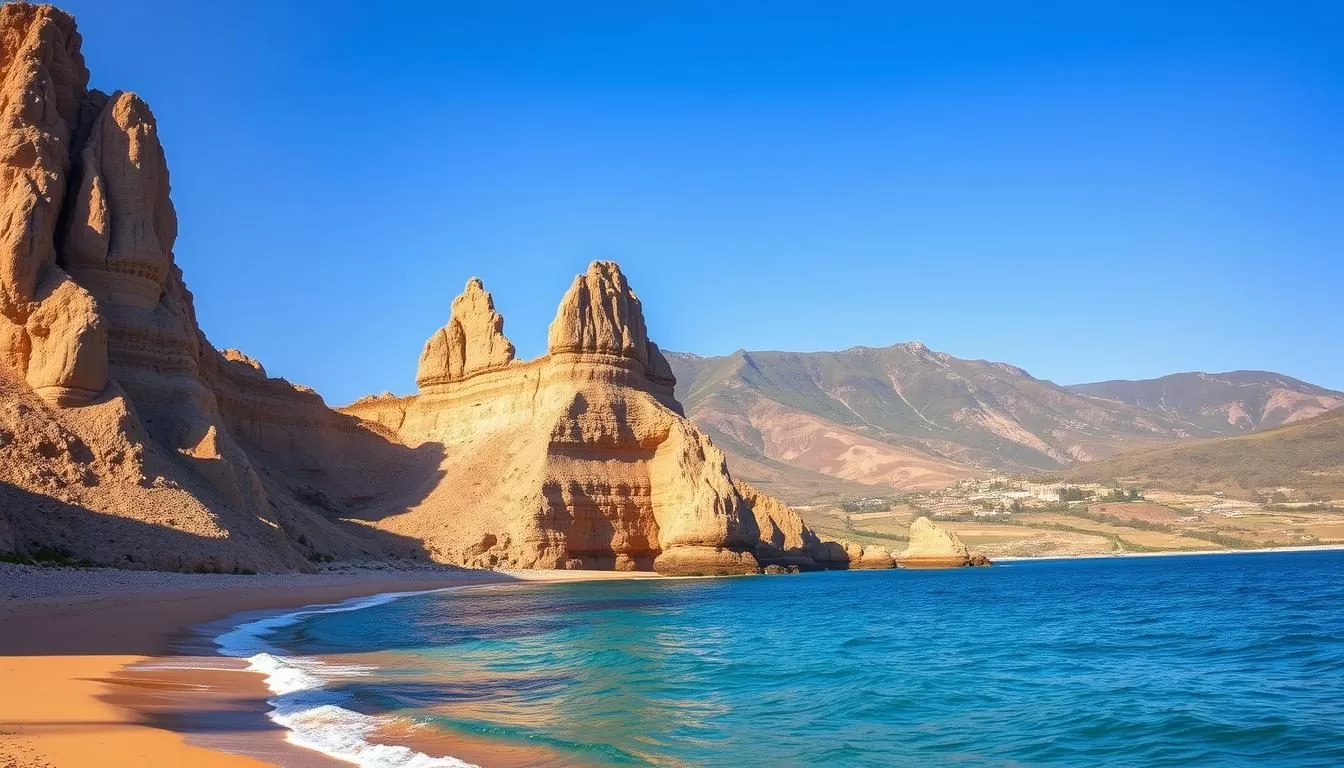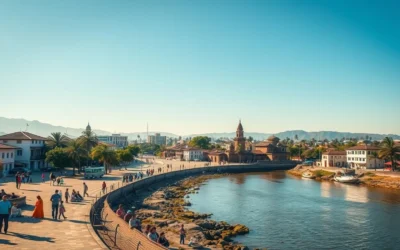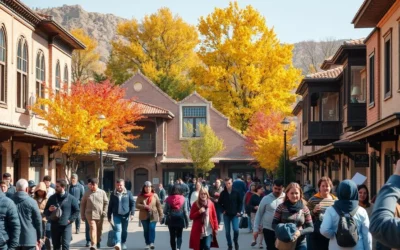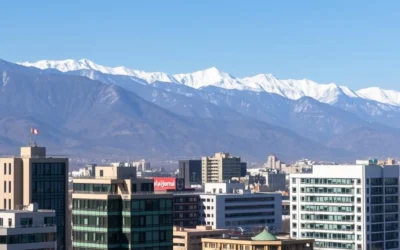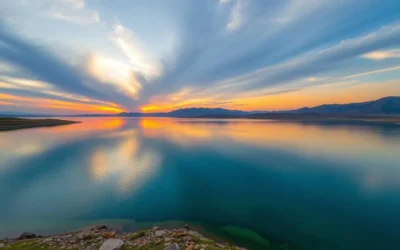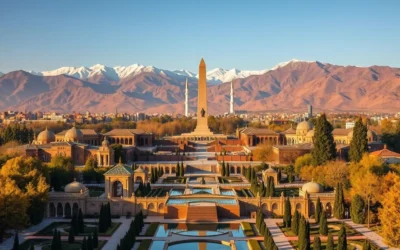✓ Accommodations✓ Flights✓ Rental Cars
Welcome to a destination like no other. Nestled in the Persian Gulf, this place is a treasure trove of natural beauty and cultural heritage. With a total area of approximately 1,500 square kilometers, it’s the largest in the region and a must-visit for any travel enthusiast.
What makes this location truly special is its recognition as a UNESCO Global Geopark. Covering over 30,000 hectares, it’s home to unique geological formations, including the world’s longest salt caves. Whether you’re exploring dramatic rock landscapes or immersing yourself in local traditions, every moment here is unforgettable.
From the ancient Kharbas Caves to the narrow Aali Mohammad Valley, this destination offers a blend of adventure and history. Pack your bags and get ready to discover a place where nature and culture come together in the most extraordinary way.
Discover Qeshm Island: An Unforgettable Persian Gulf Adventure
Step into a world where nature and history intertwine in the most fascinating ways. This destination is a UNESCO Global Geopark, recognized for its unique geological formation and cultural richness. Covering over 30,000 hectares, it’s home to stunning rock landscapes and ancient traditions that captivate every visitor.
Geographic Highlights and UNESCO Global Geopark Status
The island’s natural walls and dramatic rock formations are a testament to its geological past. These features earned it a place in the UNESCO Global Geopark network in 2006. With over 3,000 animal species and more than 1,000 square meters of museum space, it’s a hub for both nature and science enthusiasts.
From the Hara Mangrove Forests to the Stars Valley, the landscape is a blend of beauty and mystery. These areas are not just visually stunning but also hold significant ecological value.
The Island’s Unique Formation and Cultural Legacy
The island’s formation is a result of millions of years of geological activity. Its natural walls and caves, like the Namakdan Cave, are among the longest in the world. These formations are not just natural wonders but also windows into the earth’s history.
Its culture is equally fascinating. Influences from Portuguese, Dutch, and French invaders have left a lasting mark. Traditional practices, like pearl diving and fishing, are still alive today. This blend of history and tradition makes the island a living museum of human resilience and creativity.
Whether you’re exploring ancient caves or learning about local customs, every moment here is a journey through time. The island’s culture and history are as captivating as its natural beauty.
How to Get to Qeshm Island and Best Times to Visit
Planning your trip to this unique destination is easier than you think. Whether you prefer flying, taking a ferry, or traveling overland, there are plenty of options to suit your needs. Let’s explore the best ways to get there and the ideal time to visit for a memorable experience.
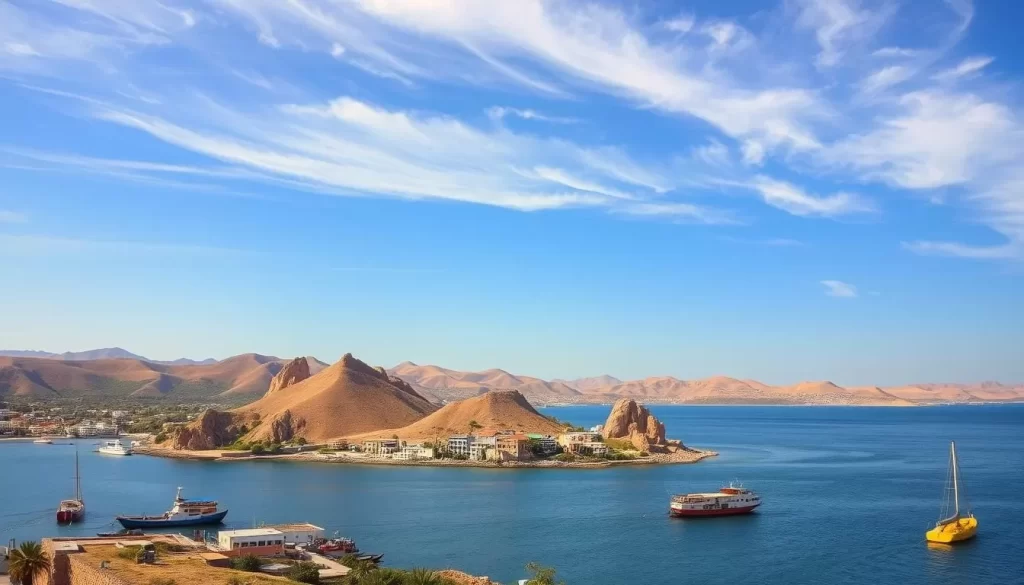
Travel Options: Flights, Ferries, and Overland Routes
Flying is the fastest way to reach this destination. Domestic flights from major cities take about 1.5 to 2 hours, with Bandar Abbas being a key hub. Once you land, you can easily connect to the island via a short ferry ride.
Ferries from Bandar Abbas are a scenic and affordable option. The journey takes around 45 minutes, offering stunning views of the Persian Gulf. Overland routes are also available, with buses and taxis providing flexibility for those who enjoy road trips.
Seasonal Climate Insights and Optimal Visiting Periods
The best time to visit is from February to November, when the weather is pleasant and rainfall is minimal. Spring and autumn are particularly ideal, with comfortable temperatures perfect for exploring. Avoid the summer months if you’re not a fan of extreme heat.
Plan your day activities wisely. Mornings and evenings are the best times to enjoy outdoor attractions, while midday is perfect for indoor experiences or relaxing by the beach.
| Travel Option | Duration | Best For |
|---|---|---|
| Flights | 1.5-2 hours | Quick and convenient |
| Ferries | 45 minutes | Scenic and budget-friendly |
| Overland Routes | Varies | Flexibility and adventure |
With these tips, your trip will be smooth and enjoyable. Whether you’re flying in or taking a ferry from Bandar Abbas, you’re in for an unforgettable experience.
Exploring Qeshm’s Natural Wonders and Iconic Landscapes
Immerse yourself in a landscape where nature’s artistry takes center stage. From serene mangroves to dramatic rock formations, this destination offers a feast for the senses. Whether you’re a birdwatching enthusiast or a photography lover, the natural wonders here will leave you in awe.
Marvel at the Hara Mangrove Forest and Birdwatching Gems
The Hara Mangrove Forest is a sanctuary of tranquility. Nestled along the coast, this lush ecosystem thrives in brackish water, creating a haven for over 220 bird species. As you wander through the forest, the soothing sounds of nature and the sight of vibrant wildlife will captivate you.
This biosphere reserve has been protected since 1972, highlighting its ecological importance. Whether you’re exploring by boat or on foot, the serene ambiance and diverse birdlife make it a must-visit for nature lovers.
Witness Erosion Art in the Valley of Stars and Chahkuh Valley
The Valley of Stars is a masterpiece shaped by wind and water. Its towering rock formations and maze-like ravines create a surreal landscape. This natural wonder, estimated to be two million years old, offers endless photo opportunities and a chance to marvel at nature’s creativity.
Chahkuh Valley is another geological gem. Its deep canyons and unique rock formations resemble sculptures carved by time. As you explore, you’ll feel like you’ve stepped into another world, where every turn reveals a new marvel.
These valleys are perfect for adventurers and photographers alike. The interplay of light and shadow on the rock surfaces creates a mesmerizing effect, especially during sunrise or sunset.
Qeshm Island, Iran: Best Things to Do – Top Picks
From breathtaking natural wonders to unforgettable marine adventures, this destination offers experiences that will leave you in awe. Whether you’re exploring underground marvels or cruising along pristine waters, every moment here is a discovery.
Namakdan Salt Cave: A World of Colorful Salt Formations
Step into the Namakdan Salt Cave, the largest salt cave in the world, stretching an impressive 6,850 meters. While only the first 100-200 meters are accessible to the public, this underground wonder is a feast for the eyes. Its vibrant salt formations, shaped over millennia, create a surreal landscape that feels like stepping into another world.
Guided tours are available, ensuring you navigate the cave safely while learning about its geological significance. The interplay of light on the salt walls adds a magical touch, making it a photographer’s paradise. Don’t forget to wear sturdy shoes and bring a jacket, as the cave’s interior can be cool and slippery.
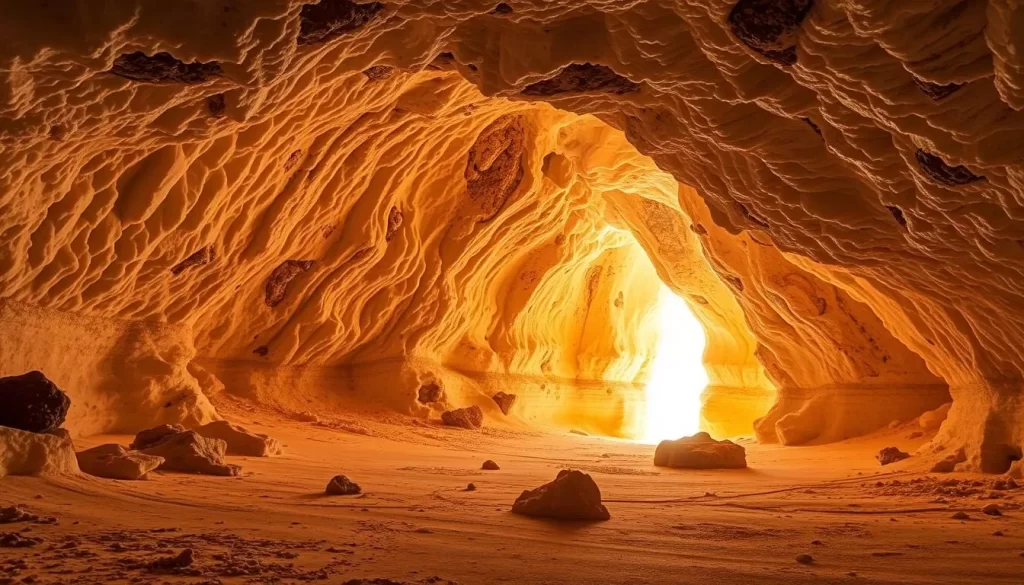
Hengam Island Excursions: Dolphins, Beaches, and Marine Life
Just 2 kilometers from the southeastern shore, Hengam Island is a paradise for nature lovers. Hop on a boat and set sail for an adventure where you’ll encounter playful dolphins, pristine beaches, and crystal-clear waters. The island’s untouched beauty makes it a perfect escape from the hustle and bustle.
Dolphin sightings are almost guaranteed, especially during the early morning hours. Afterward, relax on the island’s sandy shores or explore its vibrant marine life through snorkeling. The calm waters and serene atmosphere make it an ideal spot for unwinding and reconnecting with nature.
| Attraction | Highlights | Best Time to Visit |
|---|---|---|
| Namakdan Salt Cave | Colorful salt formations, guided tours | Morning or late afternoon |
| Hengam Island | Dolphin encounters, pristine beaches | Early morning |
These attractions are more than just sights to see—they’re experiences that will stay with you long after your visit. Whether you’re marveling at the underground beauty of the salt cave or enjoying the tranquility of Hengam Island, you’re in for an unforgettable journey.
Cultural Immersion: Experience Traditional Bandari Life
Dive into the heart of Bandari culture, where vibrant traditions and warm hospitality await. This unique way of life is deeply rooted in the coastal communities, offering a glimpse into a world where history and daily routines intertwine seamlessly.
Local Customs, Traditional Dress, and Vibrant Markets
One of the most striking aspects of Bandari culture is the traditional attire worn by women. Colorful abayas and intricate embroidery reflect the region’s rich heritage. These garments are not just clothing but a symbol of identity and pride.
Interacting with local families is a highlight of any visit. Their warmth and friendliness make you feel like part of the community. Whether you’re exploring bustling markets or attending a traditional celebration, the sense of belonging is palpable.
The markets are a hub of activity, offering everything from handmade crafts to fresh produce. Here, you’ll witness the importance of fishing in the local economy. Fishermen bring in their daily catch, showcasing centuries-old techniques passed down through generations.
Tasting Authentic Bandari Cuisine and Seafood Delights
No cultural immersion is complete without savoring the flavors of Bandari cuisine. Fresh seafood takes center stage, prepared using traditional methods that highlight the region’s coastal bounty. Dishes like grilled fish and spicy shrimp stew are a must-try.
Meals are often shared with family, emphasizing the importance of togetherness. This communal dining experience offers a deeper understanding of the Bandari way of life. Don’t forget to try the local bread, baked to perfection in traditional ovens.
As you explore the culinary scene, you’ll notice the influence of the sea in every dish. The connection between the local community and the ocean is evident, making each meal a celebration of their heritage.
Engaging with the Bandari culture is more than just an experience—it’s a journey into the heart of a vibrant and resilient community. From the colorful attire of women to the bustling markets and flavorful cuisine, every moment is a step closer to understanding their way of life.
Adventure Activities and Outdoor Island Excursions
Unleash your adventurous spirit with thrilling outdoor activities. This destination offers a unique way to explore its untamed landscapes, from arid deserts to hidden caves. Whether you’re a seasoned explorer or a first-time tourist, these experiences will leave you in awe.
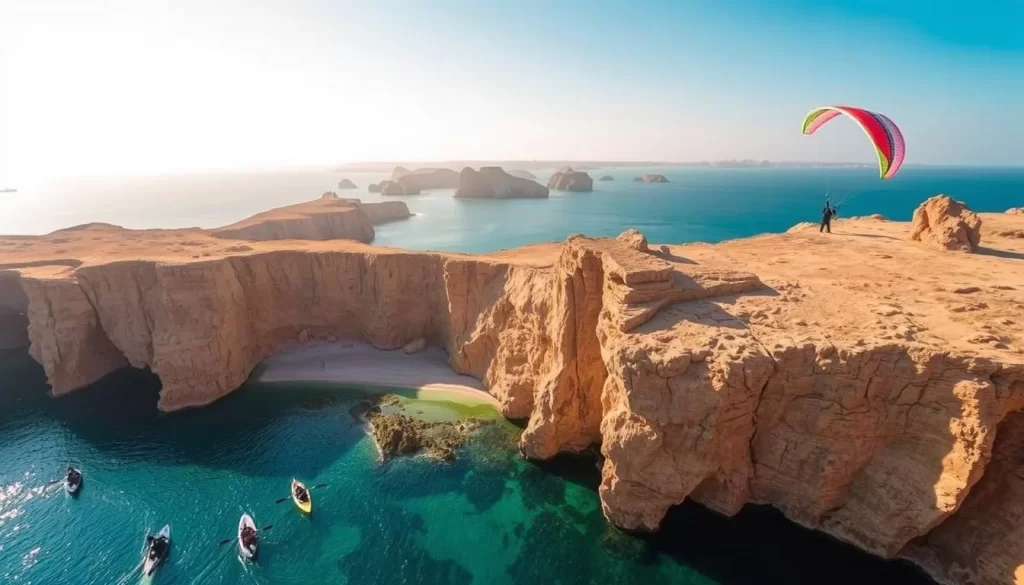
Camel Spotting and Desert Discoveries
One of the most exciting adventures is camel spotting in the desert. The arid landscapes, shaped by the wind, create a dramatic backdrop for this activity. As you traverse the sandy terrain, you’ll encounter these majestic creatures in their natural habitat.
Guided tours ensure a safe and informative experience. You’ll learn about the desert’s ecosystem and the role camels play in the local culture. Don’t forget to bring sunscreen and plenty of water, as the desert heat can be intense.
Exploring Khorbas Caves and the Naaz Islands by Boat
For a different kind of adventure, hop on a boat and explore the Khorbas Caves and Naaz Islands. These lesser-known spots are perfect for those seeking a unique way to connect with nature. The caves, carved by natural forces, offer a glimpse into the island’s geological history.
The Naaz Islands emerge from the sea at low tide, providing a surreal experience. Guided boat tours are available, ensuring you navigate these tidal wonders safely. As you cruise along, the wind in your hair and the sun on your face, you’ll feel a sense of freedom and discovery.
These activities are designed to fuel your adventurous spirit. Whether you’re spotting camels in the desert or exploring caves by boat, every moment is a step closer to an unforgettable experience.
The Geological Marvels of Qeshm: From Canyons to Cliffs
Discover the fascinating landscapes carved by centuries of natural forces. This destination is a testament to the power of erosion and tectonic activity, offering a glimpse into the earth’s dynamic history. From towering cliffs to deep valleys, every feature tells a story of transformation.
Discovering Chahkuh Valley’s Natural Engineering
Chahkuh Valley is a masterpiece of natural engineering. Its vertical walls, reaching depths of 100 meters, were shaped by wind and water over millions of years. The unique rock formations resemble sculptures, creating a surreal landscape that feels otherworldly.
This site is not just visually stunning but also scientifically significant. The valley’s geological layers reveal the earth’s history, making it a must-visit for curious explorers. Guided tours provide insights into the natural processes that formed this wonder.
Another highlight is the presence of natural salt deposits. These formations add a unique character to the landscape, creating a striking contrast against the rugged cliffs. The interplay of light and shadow enhances the valley’s dramatic appeal, especially during sunrise or sunset.
For those interested in the science behind these marvels, Chahkuh Valley offers a fascinating lesson in geology. Its formation is a result of centuries of erosion, showcasing the relentless power of nature. Whether you’re a photographer or a nature enthusiast, this site promises an unforgettable experience.
To learn more about the island’s top attractions, check out this comprehensive guide.
Local Travel Tips for a Smooth and Enjoyable Trip
Make the most of your journey with practical tips and local insights. Navigating this destination is easier than you think, especially when you know the best ways to get around and explore. From transportation options to day trip planning, these recommendations will ensure your adventure is seamless and memorable.
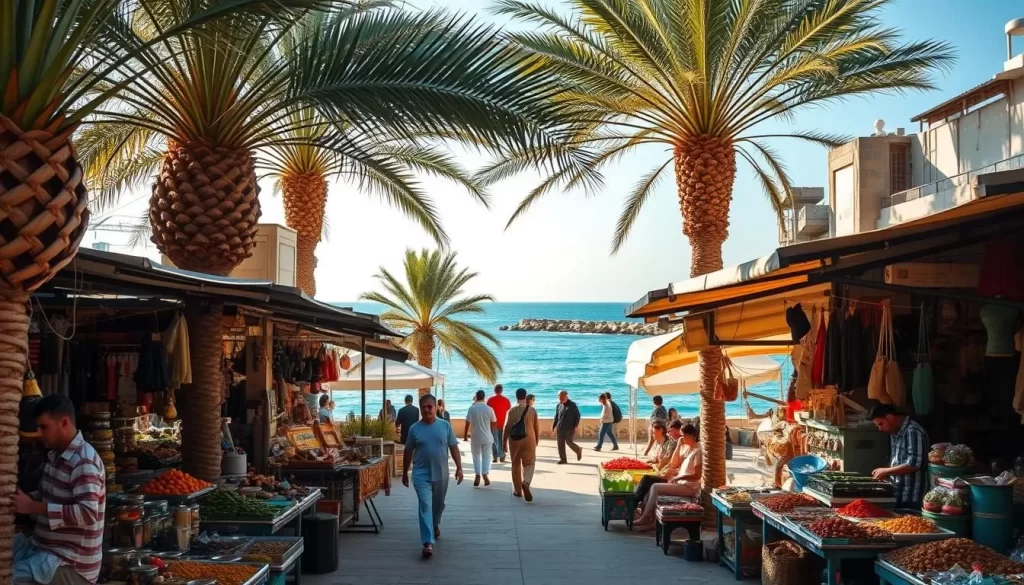
Smart Transportation Options
Getting around is a breeze with a variety of transportation choices. Taxis are widely available and affordable, making them a convenient option for short distances. For more flexibility, consider renting a car. This allows you to explore hidden gems at your own pace.
If you prefer a more local experience, public buses are a budget-friendly way to travel. They connect major attractions and are a great way to immerse yourself in the culture. For scenic routes, ferries are an excellent choice, offering stunning views of the sea and nearby islands.
Day Trip Recommendations
Plan your day trips wisely to maximize your time. Start with the Valley of Stars, a world-class place known for its unique rock formations. This natural wonder is over two million years old and offers endless photo opportunities.
Another must-visit is the Naz Islands, located just one kilometer from the coast. You can walk to them when the sea level is low, making it a unique experience. For a serene escape, head to the Hara Mangrove Forest. This lush area is home to coastal trees and diverse birdlife, perfect for nature lovers.
- Use taxis or car rentals for flexibility and convenience.
- Explore the Valley of Stars and Naz Islands for unforgettable experiences.
- Visit the Hara Mangrove Forest to enjoy the beauty of coastal trees.
For more inspiration on exploring Iran’s cultural and natural wonders, check out this guide. With these tips, your trip will be smooth, enjoyable, and filled with unforgettable memories.
A Blend of Relaxation and Excitement: Beach Days and Boat Tours
Experience the perfect balance of relaxation and adventure on your next getaway. Whether you’re looking to unwind on pristine beaches or explore the sparkling coast by boat, this destination offers something for everyone. The serene village settings and stunning beaches provide a peaceful escape from everyday life.
Unwind on Pristine Beaches
The beaches here are a true paradise, with soft sand and crystal-clear waters. They’re perfect for sunbathing, swimming, or simply enjoying the view. The best time to visit is from February to November, when the weather is ideal for beach activities.
For a more secluded experience, head to the quieter spots away from the main tourist areas. These hidden gems offer tranquility and a chance to connect with nature. Don’t forget to bring sunscreen and plenty of water to stay comfortable throughout the day.
Join Scenic Boat Tours
Boat tours are a fantastic way to explore the coast and nearby attractions. Covering several kilometers, these tours offer breathtaking views of the sea and its surroundings. One popular destination is Hengam Island, known for its playful dolphins and pristine beaches.
Early morning tours are the best for dolphin sightings, while sunset cruises provide a romantic setting. Whether you’re a nature lover or a photography enthusiast, these tours offer unforgettable sights and experiences.
- Plan your boat tours early to secure the best spots and times.
- Bring a camera to capture the stunning coastal views and wildlife.
- Check the weather forecast to ensure a smooth and enjoyable trip.
For more inspiration on exploring the Persian Gulf’s top destinations, check out this comprehensive guide. With these tips, your trip will be filled with relaxation, adventure, and unforgettable memories.
Conclusion
Your journey here will leave you with memories that feel like a part of your heart. From the refreshing days of spring to the sunny beach escapes, every moment is a treasure. The encounters with unique wildlife and the warmth of the local culture make this place unforgettable.
It’s easy to see why so many travelers feel like they’re coming back home with each visit. The blend of adventure, relaxation, and authentic experiences creates a lasting impression. Whether you’re exploring natural wonders or immersing yourself in traditions, this destination offers something truly special.
Plan your next trip with confidence, knowing that this magical place will welcome you with open arms. For more insights on exploring the region, check out this comprehensive guide.
The above is subject to change.
Check back often to TRAVEL.COM for the latest travel tips and deals.
